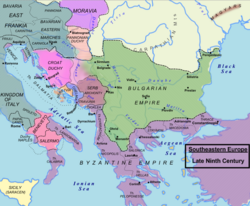Siege of Ragusa (866–868)
| Siege of Ragusa | |||||||
|---|---|---|---|---|---|---|---|
| Part of the Arab–Byzantine wars | |||||||
 Political map of the Balkans and southern Italy in the late 9th century |
|||||||
|
|||||||
| Belligerents | |||||||
|
Ragusa Byzantine Empire |
Aghlabid Emirate of Bari | ||||||
| Commanders and leaders | |||||||
| Niketas Ooryphas |
Sawdan of Bari Saba of Tarento Kalfun the Berber |
||||||
| Strength | |||||||
| unknown (Ragusa) 100 ships (Byzantines) |
36 ships | ||||||
The Siege of Ragusa (modern Dubrovnik in Croatia) by the Aghlabids of Ifriqiya lasted for fifteen months, beginning in 866 until the lifting of the siege at the approach of a Byzantine fleet in 868. The failure of the siege and the re-appearance of the Byzantines in the region of Dalmatia signalled the beginning of new aggressive western policy by the new Byzantine emperor, Basil I. Its immediate effects were the re-establishment of Byzantine authority there in the form of the Theme of Dalmatia, and the beginning of the Christianization of the Serbs and other Slavic tribes of the western Balkans, but within a few years it led to renewed Byzantine involvement and presence in southern Italy as well.
At the beginning of the reign of Basil I the Macedonian in 867, Byzantine authority over Sicily and southern Italy had been much diminished due to the expansion of the Aghlabids of Ifriqiya; likewise, in the western Balkans, the local Slavic tribes—the Croats, Serbs, Zachlouboi, Terbounites, Kanalites, Diocletians, and Rhentanoi—had thrown off Byzantine suzerainty and re-asserted their independence. As a result, the Adriatic Sea fell prey to both Slavic and Saracen pirates, the former operating from the shores of Dalmatia and the latter from their southern Italian bases at Bari, Taranto, and Brindisi.
...
Wikipedia
